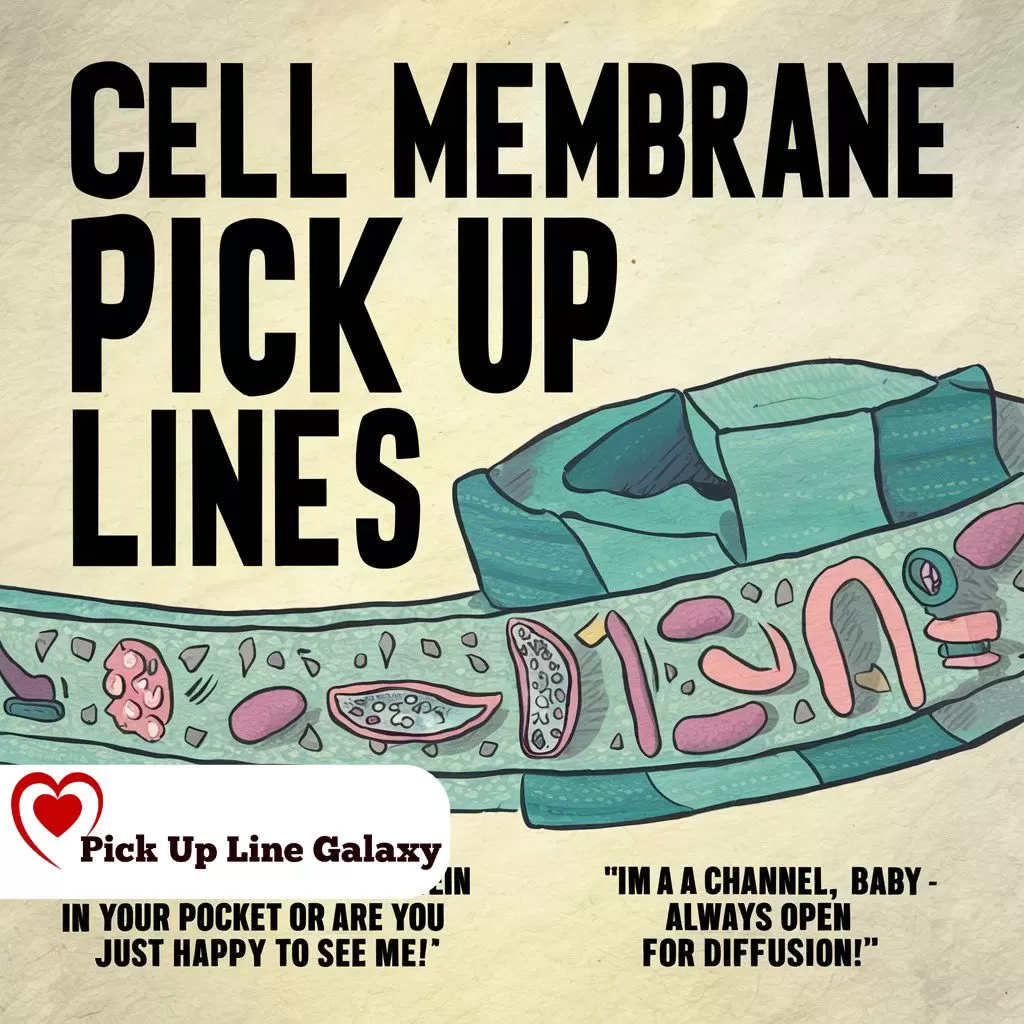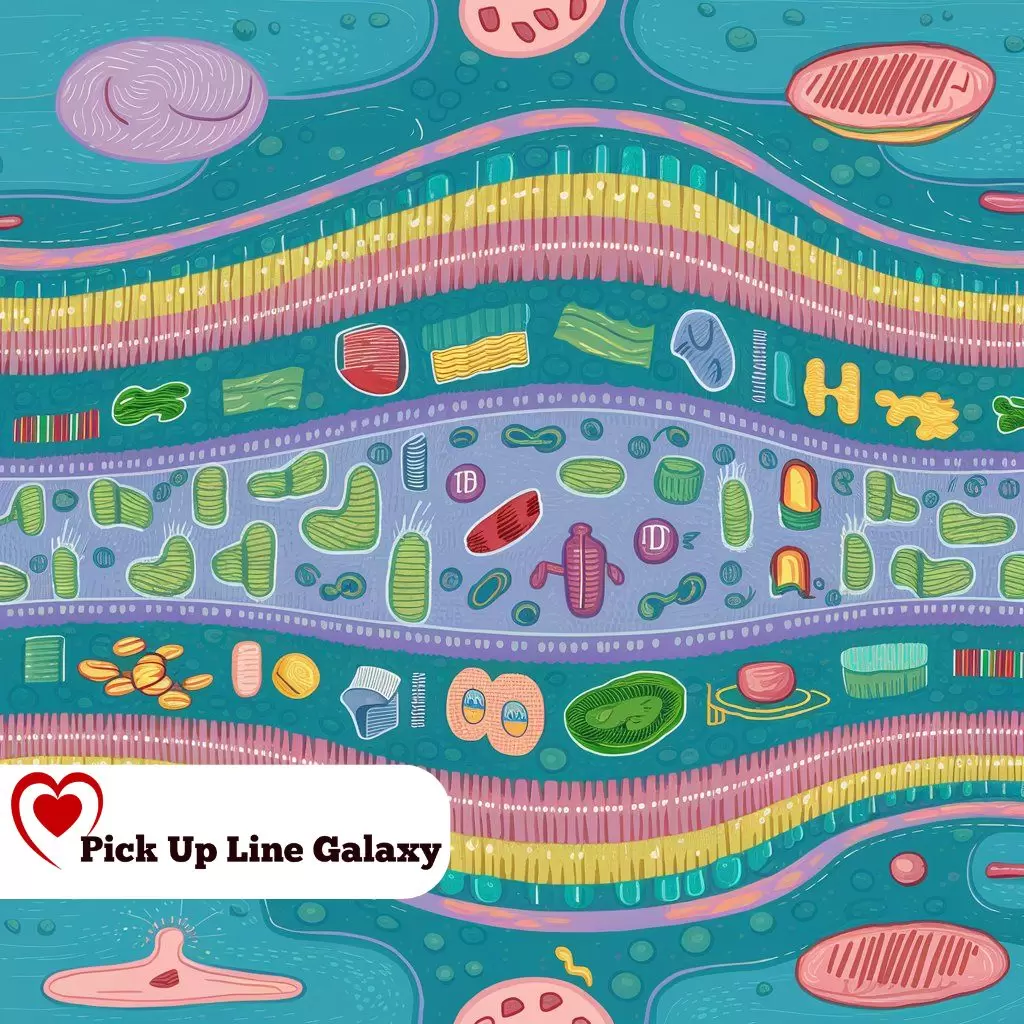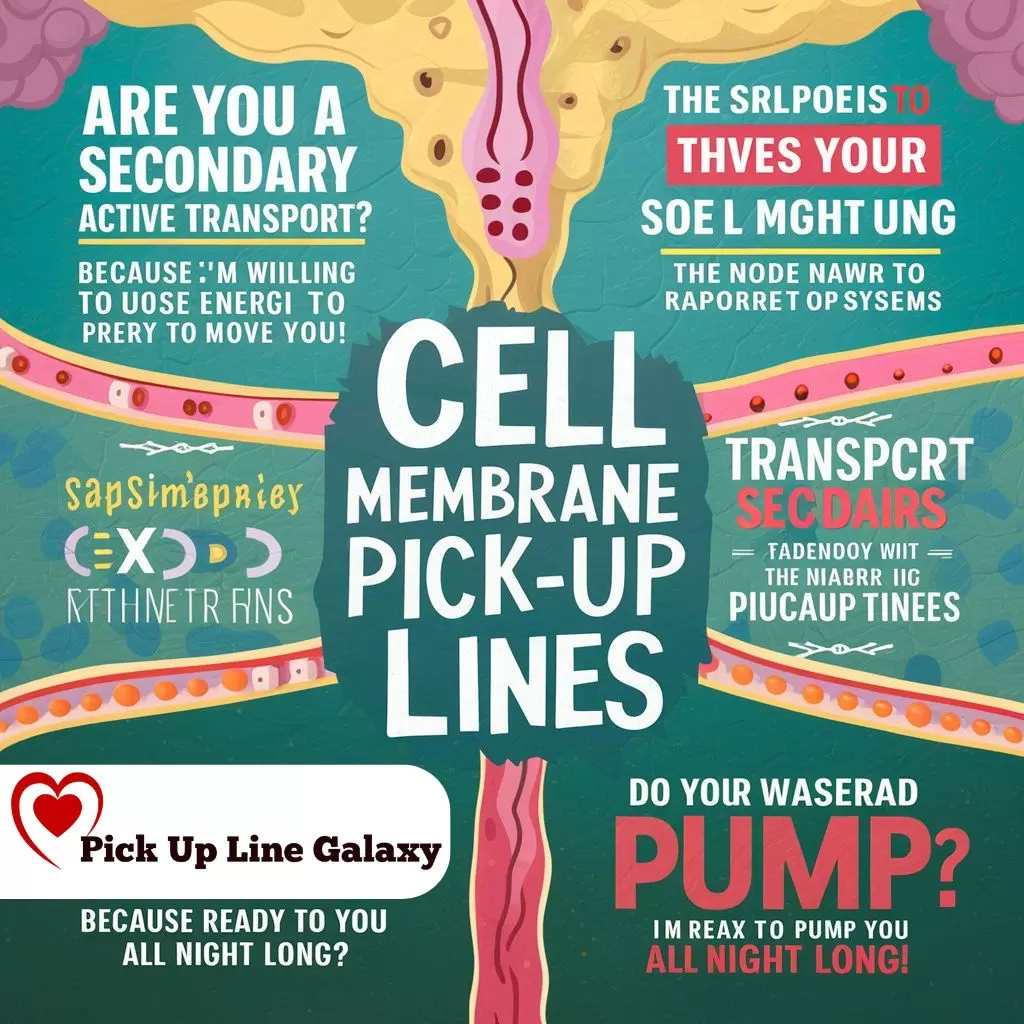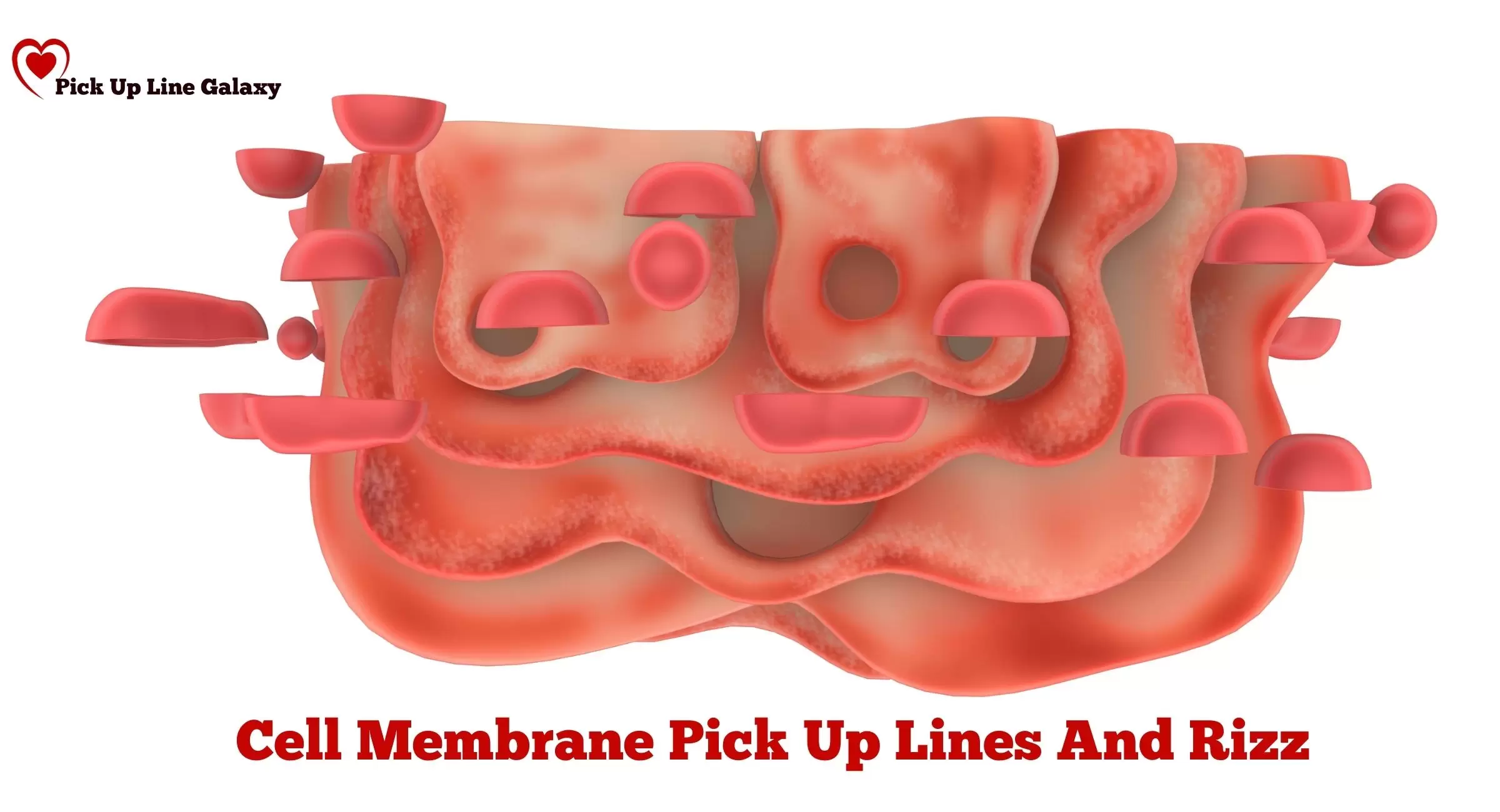Last updated on October 13th, 2024 at 10:54 am
Are you ready to dive into the world of cell membrane pick-up lines? Look no further! Whether you’re a biology enthusiast trying to impress your lab partner or just someone who appreciates a good science pun, these lines are sure to make an impression.
From phospholipids to cholesterol, we’ve got a pick-up line for every aspect of the cell membrane. So, without further ado, let’s explore 90+ cell membrane pick-up lines and Rizz!
Cell Membrane Pick Up Lines

- Are you a phospholipid? Because you make my membrane fluid.
- Is your name cholesterol? Because you make my membrane more stable.
- Are you an integral protein? Because you’ve embedded yourself into my heart.
- You must be a glycoprotein, because you’re sweet like sugar.
- Are you a receptor protein? Because you’ve caught my signal.
- You’re like a selective permeable membrane—you only let the good stuff in.
- Are you an ion channel? Because you’ve opened up a pathway to my heart.
- If you were an aquaporin, you’d help me transport my feelings for you faster.
- Are you a carbohydrate chain? Because you’re making my cell surface glycocalyx.
- You must be a sodium-potassium pump, because you’re giving me heart palpitations.
- Are you a lipid bilayer? Because you’ve got two layers to love.
- You’re like a cholesterol molecule—essential for my well-being.
- Are you a peripheral protein? Because you’re on the surface of my mind.
- You’re the integral to my membrane.
- Are you a phospholipid bilayer? Because you’re keeping me together.
- You’re like a plasma membrane—essential for my survival.
- Are you a fluid mosaic model? Because you’ve arranged yourself perfectly in my life.
- You must be a cell wall because you provide structure to my life.
- Are you a carrier protein? Because you’ve transported my feelings for you.
- You’re like a plasma membrane—semi-permeable to everyone but my heart.
- Are you an ion pump? Because you’re maintaining the balance in my life.
- You must be a glycolipid because you’re making my cell surface special.
- Are you a transport protein? Because you’re moving my emotions.
- You’re like a lipid raft—stabilizing my life.
- Are you a permeable membrane? Because you’ve allowed love to pass through.
- You must be a phosphorylated protein because you’ve added energy to my life.
- Are you an exoplasmic marker? Because you’ve marked a special place in my heart.
- You’re like a microvillus—increasing my affection for you.
- Are you a carrier molecule? Because you’ve carried away my heart.
Read More: Halal Pick Up Lines And Rizz
Read Also: Top 120+ Happy Birthday Pick Up Lines
About Cell Membrane

- The cell membrane is a semipermeable barrier that surrounds the cell, controlling what enters and exits.
- It consists of a phospholipid bilayer embedded with proteins, cholesterol, and carbohydrates.
- Phospholipids are the main structural components of the cell membrane, with hydrophilic heads and hydrophobic tails.
- Cholesterol molecules are interspersed within the phospholipid bilayer, adding stability to the membrane.
- Integral proteins span the entire width of the membrane, playing key roles in transport and signaling.
- Peripheral proteins are found on the inner or outer surface of the membrane, aiding in cell shape and movement.
- Glycoproteins and glycolipids are carbohydrate chains attached to proteins and lipids, respectively, involved in cell recognition.
- Receptor proteins bind specific molecules outside the cell, initiating cellular responses.
- Ion channels facilitate the passage of ions across the membrane, maintaining cellular homeostasis.
- Transport proteins assist in the movement of substances across the membrane, including ions, sugars, and amino acids.
- Carrier proteins undergo conformational changes to transport molecules across the membrane, often against their concentration gradient.
- Selective permeability allows only certain substances to pass through the membrane while restricting others.
- The fluid mosaic model describes the cell membrane as a dynamic structure with proteins floating in a fluid lipid bilayer.
- Lipid rafts are small, dynamic assemblies of lipids and proteins that serve as signaling platforms in the membrane.
- Exoplasmic markers are molecules on the outer surface of the membrane that identify the cell type.
- Transport vesicles shuttle molecules between organelles and the cell membrane.
- Aquaporins are specialized channels that facilitate the rapid movement of water across the membrane.
- The glycocalyx is a fuzzy coat of carbohydrate chains on the cell surface involved in cell-cell recognition.
- Cell adhesion molecules mediate the adhesion of cells to each other and to the extracellular matrix.
- Signal transduction involves the relay of signals from the cell exterior to the interior, often mediated by membrane-bound receptors.
- Endocytosis and exocytosis are processes by which large molecules are transported into and out of the cell, respectively.
- Phagocytosis is a type of endocytosis in which solid particles are engulfed by the cell.
- Pinocytosis involves the ingestion of extracellular fluid and solutes.
- Membrane potential refers to the voltage across the cell membrane, maintained by the differential distribution of ions.
- Resting membrane potential is the voltage difference across the membrane when the cell is at rest.
- Active transport requires energy expenditure to move molecules against their concentration gradient.
- Passive transport does not require energy and relies on diffusion to move molecules down their concentration gradient.
- Facilitated diffusion involves the use of transport proteins to facilitate the movement of specific molecules across the membrane.
- Osmosis is the diffusion of water across a selectively permeable membrane, from an area of lower solute concentration to an area of higher solute concentration.
Cell Membrane Pick Up Lines Tips

- Tip 1: Tailor your pick-up line to your audience—some may appreciate a clever biology pun, while others may prefer a simpler approach.
- Tip 2: Practice delivery and timing—confidence can make even the nerdiest pick-up line charming.
- Tip 3: Be genuine and sincere—showing interest in someone’s passion for biology can be endearing.
- Tip 4: Use humor—humorous pick-up lines can break the ice and make the interaction more lighthearted.
- Tip 5: Incorporate cell membrane terminology—show off your knowledge while impressing your crush.
- Tip 6: Be respectful—if someone doesn’t respond positively to your pick-up line, gracefully move on.
- Tip 7: Keep it light—pick-up lines are meant to be playful and fun, not serious declarations of love.
- Tip 8: Pay attention to body language—if someone seems uninterested or uncomfortable, respect their boundaries.
- Tip 9: Don’t overdo it—while a well-timed pick-up line can be memorable, bombarding someone with lines can be overwhelming.
- Tip 10: Have fun with it—pick-up lines are meant to spark conversation and laughter, so don’t take yourself too seriously.
- Tip 11: Be confident—confidence is attractive, so own your pick-up line with pride.
- Tip 12: Be observant—pay attention to your surroundings and find creative ways to incorporate them into your pick-up line.
- Tip 13: Be positive—keep the energy upbeat and optimistic to create a more enjoyable interaction.
- Tip 14: Be memorable—stand out from the crowd by using a unique pick-up line that your crush won’t forget.
- Tip 15: Be complimentary—make your crush feel special by complimenting something unique about them.
- Tip 16: Be adaptable—if your initial pick-up line doesn’t land, be prepared to improvise and try something different.
- Tip 17: Be playful—don’t be afraid to tease and banter with your crush to keep the conversation light-hearted.
- Tip 18: Be engaging—ask open-ended questions to encourage your crush to share more about themselves.
- Tip 19: Be confident in silence—sometimes, a well-timed pause can be just as effective as a witty pick-up line.
- Tip 20: Be respectful of boundaries—always ask for consent before engaging in flirtatious banter.
- Tip 21: Be authentic—don’t try to be someone you’re not; authenticity is attractive.
- Tip 22: Be patient—building rapport takes time, so don’t rush the process.
- Tip 23: Be attentive—listen actively to what your crush is saying and respond thoughtfully.
- Tip 24: Be creative—think outside the box and come up with pick-up lines that are unexpected and original.
- Tip 25: Be supportive—show genuine interest in your crush’s interests and passions.
- Tip 26: Be confident in vulnerability—don’t be afraid to show your softer side and share personal stories.
- Tip 27: Be respectful of rejection—if your crush isn’t interested, gracefully accept their response and move on.
- Tip 28: Be mindful of cultural differences—pick-up lines that may be acceptable in one culture could be offensive in another.
- Tip 29: Be aware of power dynamics—avoid using pick-up lines in situations where there is a significant power imbalance.
- Tip 30: Be yourself—authenticity is key to building genuine connections, so don’t be afraid to let your true self shine.
Conclusion
In conclusion, cell membrane pick-up lines can be a fun and creative way to break the ice and show off your knowledge of biology. Whether you’re wooing a fellow science enthusiast or just trying to inject some humor into your romantic pursuits, these lines offer something for everyone. From phospholipids to ion channels, each pick-up line is designed to make you stand out and leave a lasting impression. So why not give them a try and see where the conversation takes you?










